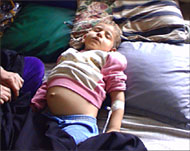Pollutants linked to childhood cancer
Most childhood cancers are probably caused by exposure in the womb to environmental and industrial pollutants that have been inhaled by the mother, a British researcher has said.

George Knox, an emeritus professor at the University of Birmingham in England, compared birth and death records of children who had died from cancer with a chemical emissions map of Britain.
He found that children born within a 1km radius of chemical emission hotspots were two to four times more likely to die of cancer before reaching 16 than other children.
“Most childhood cancers are probably initiated by close perinatal (around birth) encounters with one or more of these high emissions sources,” said Knox.
Being born near high-emission sites of the organic compounds carbon monoxide and 1,3-butadiene carried the highest risks.
Carbon monoxide is a product of internal combustion engines, used in cars, and 1,3-butadiene is used to manufacture synthetic rubber. It is also a product of internal combustion engines.
“These diseases are determined very early in life, probably prenatally,” Knox said. “They are related to atmospheric emissions that are probably absorbed by the mother and passed across the placenta.”
Particulate matter, nitrogen oxides, which are linked to oil burning and compounds such as benzene, benz(a)pyrene and dioxins were also mentioned in the study reported in the Journal of Epidemiology and Community Health.
Hotspots
The maps produced by the UK National Atmospheric Emissions Inventory measured emissions of different chemicals per square kilometre per year across the country for 2001.
|
“Most childhood cancers are probably initiated by close perinatal encounters with one or more of these high emissions sources” George Knox, |
Different patterns depict varying types of chemicals.
Knox converted the hotspots into map references and measured the distances between them and the birth and death addresses of the children born between 1960 and 1980 who had died of cancer.
“It was the birth addresses which were closer to these hotpots,” said Knox, adding it suggests exposure occurred before or shortly after the birth.
Most of the hotspots in 2001 would have been present when the children had been born.
Exposure
 |
|
About 70% of childhood cancers |
“With that assumption, one can say that these children were exposed at the level shown or probably at higher levels in many cases,” Knox said.
Childhood cancers are rare. They occur in about one in 1000 children, but in some of the hotspots it is three or four per 1000. Cancer experts say the disease has risen steadily in European children in recent decades but that survival rates have improved.
About 70% of childhood cancers are successfully treated.